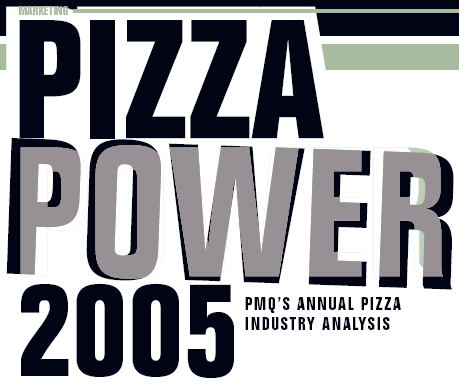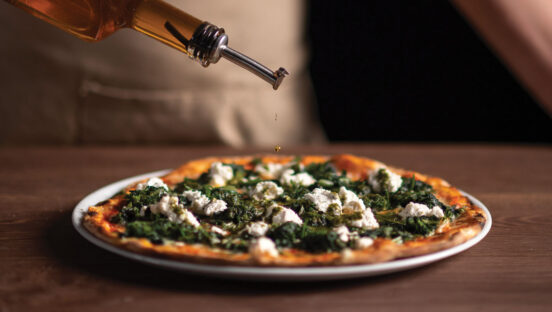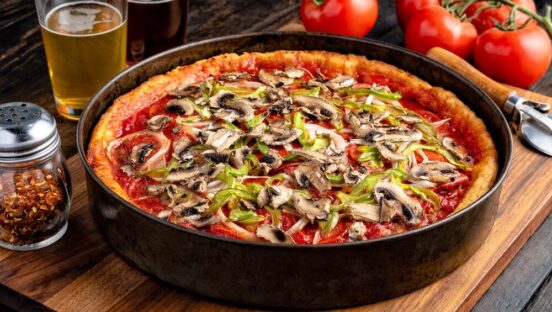The pizza industry in the U.S. has reasons to celebrate this year and reasons to be concerned. After collecting data on the past year, PMQ brings you the 2005 Pizza Power report with some interesting results. Pulling data from InfoUSA, Technomic, NPD Crest, the National Restaurant Association and Leading Edge Reports, we have complied all of this data to give you an analysis of how our industry performed compared to the previous year and the entire restaurant industry. Our numbers are collected from July 2004 through July 2005. So let’s see how we did.
The Industry as a Whole
There are three bits of good news when looking at the industry as a whole. First, there are 1.7 percent more pizzerias in America. Second, sales rose 2 percent indicating more growth than the previous year. A third sign of positive change is that only 388 pizzerias went out of business according to statistics from InfoUSA, which is down from 1,139 that closed the previous year. The total number of pizzerias in the U.S. reached 69,844 as of July 2005 compared to 68,694 at the time of the 2004 Pizza Power report.
Average per/unit sales for pizzerias in the U.S. for the period between July 2004 and July 2005 is $442,492 per location, which is up 0.3 percent from the previous year. The reason the per/unit percentage change is lower than the overall growth rate is a result of the growth rate of total pizzerias being higher than the overall sales growth.
The National Restaurant Association’s (NRA) Restaurant Industry Forecast for 2005 predicts a total of 900,000 restaurants and total sales of $475.8 billion by the end of 2005. This will average $528,667 per/unit, leaving the pizza industry falling short of the national per/unit average for all restaurants. The NRA’s per/unit sales prediction for 2004, was $501,253 per/unit. The NRA’s numbers show a change in average sales per/unit for all restaurants between 2004 and 2005 of 5.5 percent. While the pizza industry is gaining sales and locations, it is still behind the national per/unit averages for all restaurants in the U.S.
NPD Crest reports serving of pizza at restaurants were up 2 percent, which is a positive shift from being down 1 percent the previous year. According to NPD Crest, traffic in the QSR Pizza Category was flat and traffic in the Casual Dining Pizza Category was up 5 percent.

The Independents
For this report, independents are classified as all pizzerias not in the Top 25. Once again the independents gained market share of the total number of pizzerias in the U.S. and now comprise 64.3 percent of all the pizzerias in the U.S., which is up from 64.2 percent the previous year, but lost market share of total sales. Between July 2004 and July 2005, independents earned 49.22 percent of the industry’s total sales compared to earning 50.7 percent of the total industry sales the previous year. For 2004, independents earned an average of $338,745 per/unit compared to $341,534 per/unit the previous year. This marks a decrease of 0.8 percent. What does this mean? Independents are opening more locations than the Top 25, but the Top 25 are outpacing independents in sales. While this may be true, it does not necessarily mean the Top 25 are doing the best job of expanding our industry as a whole. We’ll explain more as we go here.
The Top 25
The Top 25 chains are ranked based on sales. The big news of the Top 25 is that they are not expanding the number of locations so much, but are finding success in capturing sales in the pizza category. Let’s look at the basics. The Top 25 increased their share of the total industry sales and now posses 50.78 percent of the $30.9 billion dollars in pizza sales. This means that of their 24,935 units (which represent 35.7 percent of all pizzerias in the U.S.; SOURCE: Technomic), they are being more successful at increasing average per/unit sales. Average per/unit sales for the period between July 2004 and July 2005 was $629,334, which is up 3.6 percent from $607,364 per/unit the previous year.
Here are some interesting notes about the Top 25. In the Top 25 category, there were three new companies that were not ranked as a Top 25 pizzeria last year. Those pizzerias were Greek’s Pizzeria, Jet’s Pizza and Imo’s Pizza. Of the Top 25, only three chains showed lower sales than the previous year and they were Donato’s Pizza, Pizza Inn and Mr. Gatti’s. Ten of the Top 25 chains showed a decrease in the number of units from the previous year. They were (in no particular order) Pizza Hut, Papa John’s, Little Caesars, Sbarro, Donato’s, Pizza Inn, Mazzio’s Pizza, Papa Gino’s, Mr. Gatti’s and Pizzas of Eight.
Some of those Top 25 who appear to have performed better than others either in sales or overall growth were as follows. Pizza Hut’s sales were up 4.5 percent while units were down 0.3 percent from the previous year. Chuck E. Cheese’s sales were up 9.2 percent and units were up 6.3 percent from the previous year. CiCi’s Pizza’s sales were up 14.5 percent and units were up 11.2 percent. Papa Murphy’s sales were up 13.2 percent and units were up 12.1 percent from the previous year. Peter Piper’s sales were up 10 percent while units remained the same from previous year. Fox’s Pizza Den showed a rise in sales of 28 percent while units were up 6.1 percent from the previous year. Greek’s Pizza showed sales increases of 16.9 percent with number of units up 0.8 percent. Jet’s Pizza’s sales were up 31.9 percent while units increased 32.5 percent from the previous year.
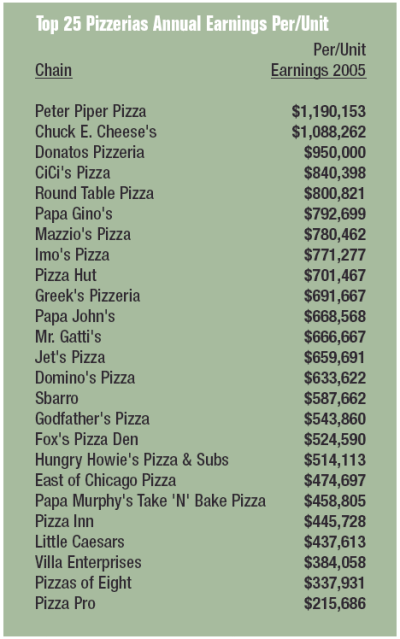
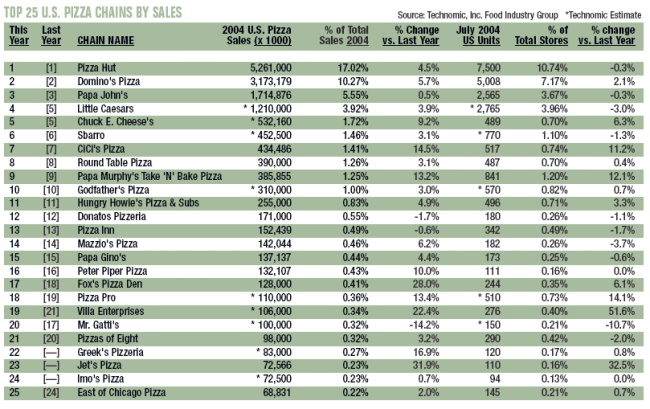

PMQ’s Pizza Industry Enterprise (PIE) Award Winner
PMQ would like to congratulate this year’s winner of the PIE Award, Fox’s Pizza Den. Fox’s showed a rise in sales of 28 percent while units were up 6.1 percent indicating strong sales growth while adding units and expanding their market. Fox’s Pizza Den averaged 524,590 per unit and has 244 locations. You can read more about Fox’s in the next issue of PMQ or catch them at the New York Pizza Show November 1st where representatives will be present to accept PMQ’s 2005 PIE Award.
What Happened in 2004?
For years, not only have independents had to deal with deep discounting, but the “big players” in pizza have fought for customers with low-priced $5 pizzas and coupons. In 2004, it appeared that the Big Four (Pizza Hut, Domino’s, Papa John’s and Little Caesars) were going to call off the price war. They began offering new menu items, such as chicken with Domino’s Chicken Kickers, Papa John’s first venture into chicken wings and strips and Pizza Hut’s Buffalo Chicken Pizza. They also offered new menu items like Domino’s DoubleMelt and American Cheeseburger Pizzas, Papa John’s Spinach Alfredo and Spicy Meatball Pizzas and Pizza Hut’s Pepperoni Trio. But, as the year came to an end they went back to their old habits of deep discounting. While this boosts initial sales, it may also be revealing the Achilles heel of our industry.
What Should We Do?
As seen by comparing the pizza industry to the entire restaurant industry, pizza is failing to pull customers away from the hamburger, taco, sandwich and chicken guys. It appears that rather than fighting to expand pizza’s customer base, the deep discounting by the major chains is simply a war of attrition that is pulling pizza customers from one pizza place to another. Perhaps there needs to be a shift and an effort with marketing towards expanding your customer base, introducing new products or a healthy angle to keep this industry “fresh” and “exciting.” The Big Four’s move in early 2004 to offer new items was a step in the right direction, but the “555 Deal,” “$5 National Pizza Sale” and numerous low-priced pizza offers and coupons is simply going to make customers “bargain hunt” for the cheapest pizza they can find. Americans’ love for pizza won’t go away, but there needs to be a movement to educate customers on the quality, uniqueness and value of pizza.
A $15 to $20 meal from a pizzeria can feed three to four people. Try feeding the same number of people chicken, burgers and fries or sandwiches for around $5 each. It’s hard to do and maybe this is a point pizza companies need to push rather than short-term discounts. Pizzas are made to order and this ability to customize and feed multiple persons for around five dollars each is a unique selling point that few other restaurant categories can boast. Are you being suckered in to the price wars? It’s a no-win situation and it’s hurting our industry.
Trends
In the past year, PMQ has traveled to Italy, Australia, New Zealand, Canada, France and coast to coast across the U.S. speaking with pizza and restaurant professionals and experts. In our travels we have noticed several trends that should be noted. Based on conversations and information from NRA’s Industry Forecast, let’s talk about a few trends.
Healthy Choices and “Buzz Words”
While the low-carb and no-carb trends have run their course, healthy alternatives and choices are something that have taken a root in the restaurant industry. According to a survey by the NRA, here are trends restaurant operators are reporting as in popular demand. As you will note, nearly all of these relate to healthy lifestyles. Percentages represent the percent of operators reporting an increase in popularity:
Entree Salads – 78 percent
Bottled Water – 69 percent
Poultry – 62 percent
Sandwiches w/o bun/bread – 50 percent
Side Salads – 48 percent
Also in the NRA report, a consumer research survey they conducted identified 10 key words and phrases that “add a lot of interest” to the consumers’ menu choice when deciding on what they will order. These words are: “Fresh, farm fresh,” “homemade,” “grilled, charcoal-grilled,” “roasted,” “charbroiled, broiled,” “baked,” “barbequed,” “marinated,” “saut�ed” and “hearty.” The report also cited a percentage of consumers who have never tried certain foods but said they would be interested in trying the following items; Ciabatta, empanadas, Tandoori, Falafel, goose, California rolls, lemon grass and gnocci.
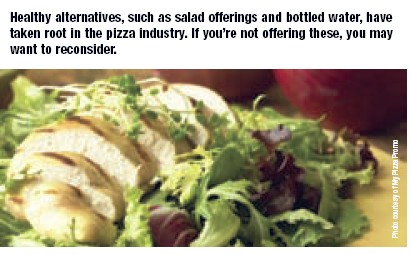
This report also found that there were words that at least one out of five consumers gave low marks. These words are: “”raw,” “deep-fried, fried or flash-fried,” “blackened,” “infused,” and “pureed.”
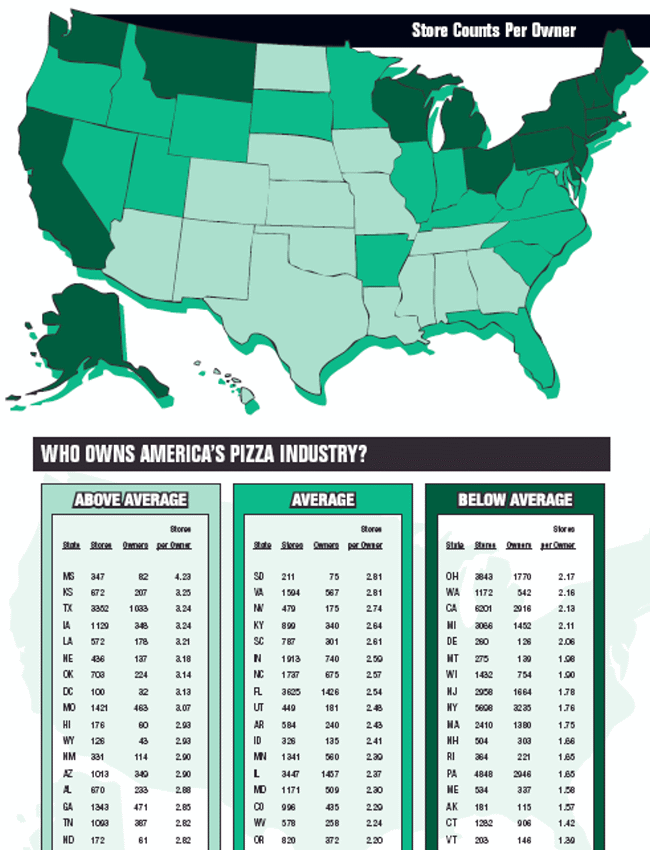
America is Becoming More Diverse
 According to the NRA, the Hispanic population has grown 6 percent since 1980 and now accounts for 13 percent of our population. The U.S. Census Bureau has estimated this growth to continue and the Hispanic population to be at 14.6 percent by 2010. In comparison, the African-American population was 12 percent in 2003 and is only predicted to reach 13 percent by 2010. This is a trend that needs to be watched and considered in the restaurant industry. Offering bi-lingual menus and staff can be beneficial.
According to the NRA, the Hispanic population has grown 6 percent since 1980 and now accounts for 13 percent of our population. The U.S. Census Bureau has estimated this growth to continue and the Hispanic population to be at 14.6 percent by 2010. In comparison, the African-American population was 12 percent in 2003 and is only predicted to reach 13 percent by 2010. This is a trend that needs to be watched and considered in the restaurant industry. Offering bi-lingual menus and staff can be beneficial.
Restaurant design
 There are new tax depreciation rules in effect for restaurants making improvements. QSR (quick service restaurants) are remodeling and trying to lure customers in the door with design. Check with your CPA about these incentives. It may be time to look at giving your restaurant a facelift.
There are new tax depreciation rules in effect for restaurants making improvements. QSR (quick service restaurants) are remodeling and trying to lure customers in the door with design. Check with your CPA about these incentives. It may be time to look at giving your restaurant a facelift.
Keep Them Coming
 With the restaurant industry growing, it is getting more and more difficult to retain your existing customers. One trend that is maturing is customer loyalty programs. With so many choices, flavors and ethnic varities, people are expanding their tastes. Initiate reward programs that give back to those repeat customers and let them know you appreciate their business.
With the restaurant industry growing, it is getting more and more difficult to retain your existing customers. One trend that is maturing is customer loyalty programs. With so many choices, flavors and ethnic varities, people are expanding their tastes. Initiate reward programs that give back to those repeat customers and let them know you appreciate their business.
Kids and Families are Big Business
 Two notable companies that have brought to light the importance of marketing to families and kids are CiCi’s Pizza and Chuck E. Cheese. While the Big Four were busy competing on price and product launches, these two competed on another front and made advances. Chuck E. Cheese is busy remodeling locations and planning on opening 30 to 35 locations this year and has seen sales increases for several years now. Like the McDonald’s Playlands, the ‘fun’ environment and games have given their kid demographic (three-to eight-year-olds) more reason to push parents to go to their locations. Games and activity centers can be a big draw even with the expanding home video games, which are generally more appealing to older kids and teenagers. CiCi’s hits the other side by appealing to the parents of larger families. By offering a broad range of choices at a good price, they have continued to capture these ‘groups’ needing to feed several people at a low price. Their advantage over the Big Four is that they aren’t competing to capture the ‘bargain hunters’ looking for the cheapest coupon. Their price remains the same and everyone can choose to eat what they like without limiting themselves to just one or two types of five-dollar pizzas with one topping.
Two notable companies that have brought to light the importance of marketing to families and kids are CiCi’s Pizza and Chuck E. Cheese. While the Big Four were busy competing on price and product launches, these two competed on another front and made advances. Chuck E. Cheese is busy remodeling locations and planning on opening 30 to 35 locations this year and has seen sales increases for several years now. Like the McDonald’s Playlands, the ‘fun’ environment and games have given their kid demographic (three-to eight-year-olds) more reason to push parents to go to their locations. Games and activity centers can be a big draw even with the expanding home video games, which are generally more appealing to older kids and teenagers. CiCi’s hits the other side by appealing to the parents of larger families. By offering a broad range of choices at a good price, they have continued to capture these ‘groups’ needing to feed several people at a low price. Their advantage over the Big Four is that they aren’t competing to capture the ‘bargain hunters’ looking for the cheapest coupon. Their price remains the same and everyone can choose to eat what they like without limiting themselves to just one or two types of five-dollar pizzas with one topping.
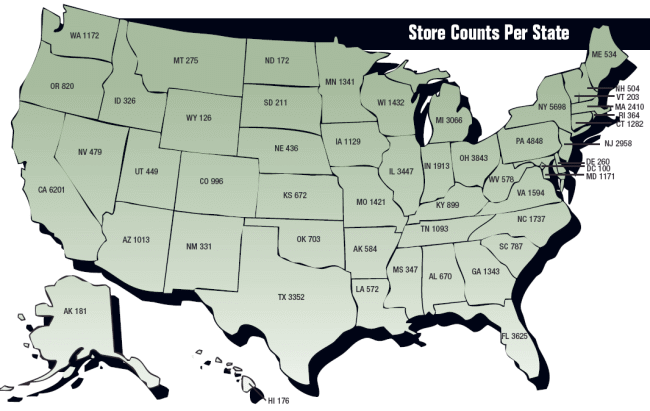
Conclusion
The past year was positive for the pizza industry, but performance is still lagging behind the restaurant industry as a whole. While we are growing, so is every other restaurant – but at a faster pace than pizza. The Big Four took a step in the right direction with new product launches last year and saw increased sales by broadening their customer base, but once again resorted back to the price war in their fight to capture each others’ customers rather than target other segments’ customers like burgers, chicken and sandwiches. With several chicken products being introduced by the Big Four and increased sales, a broader menu may be the answer to the pizza industry’s below average gains compared to the rest of the restaurant industry. Deep discounted pizzas are an option for those needing a lot of food at a low price, but rather than being the primary marketing message, it should be further down on the list behind new menu offerings and customer loyalty. The answer may be in enticing NEW customers in your doors and give them multiple reasons to come back through rewards for loyalty and more choices rather than fighting a price war. The problem of our industry is the pizza price wars and deep discounts. Customers who chose KFC, Taco Bell, Subway and Quiznos and not pizza are the ones we need to target. Let’s learn from others, like Quiznos and Subway who are competing and building their brands and customers on quality and taste rather than price. Subway promotes healthy and fresh while Quiznos promotes taste (“Toasted is Better”).
An Invitation to the pizza industry
There is no better time than the present to put our heads together. The pizza industry is not providing the booming growth to which we have become accustomed over the last three decades. As a mature industry, now is the time for the pizza operators, chain executives, advertising agencies, food boards, distributors and all pizza industry media to join together and develop strategies which will benefit our industry at large. PMQ is setting the stage to develop a national pizza marketing board much like what you have seen with Beef (“It’s What’s For Dinner”) and Milk (“Got Milk?”). PMQ would like to invite the industry’s leaders to join us on the PMQ Pizza Cruise, which takes place January 22-29, 2006, to help develop a national marketing strategy/campaign for pizza. We have recently helped produce two one-hour specials on the Food Network and just had the first-ever national independent pizza promotion with the History Channel and now want to take the next step to push our industry over the top. Imagine what we can do together with the coordinated and collective brainpower of our industry. We will discuss possible directions to lead the pizza industry, the forming of the Pizza Marketing Board and try to create solutions to put pizza on a growth pace that exceeds national restaurant statistics. Join us for the Summit on the Sea and help redirect the future of pizza. Visit www.pizzacruise.com for more information.



